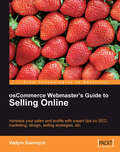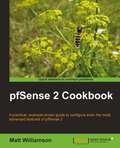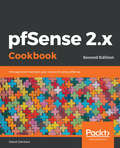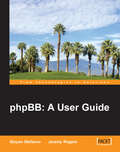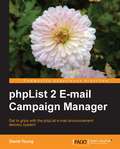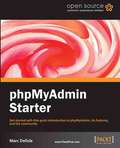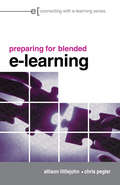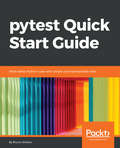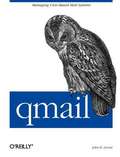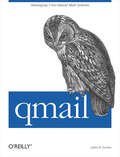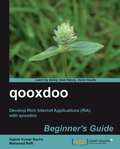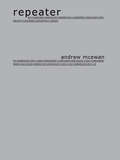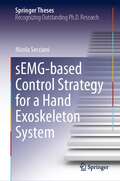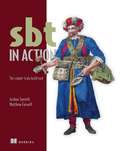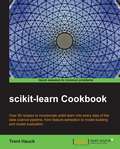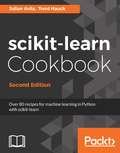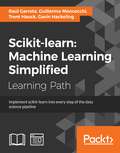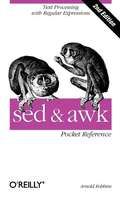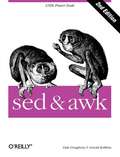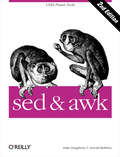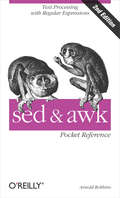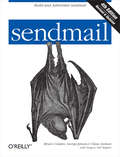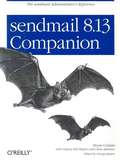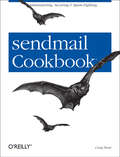- Table View
- List View
osCommerce Webmaster's Guide to Selling Online
by Vadym GurevychPacked with expert advice and practical examples of effective store design and report creation to help you make better decisions, formulate more effective strategies, and measure your success. This book is for anyone administering an osCommerce site, including webmasters, content managers, store owners, and marketing managers, who do not need to understand PHP or MySQL to benefit from this book. The tips and techniques described in this book can be applied to any small, medium sized e-commerce site. This is not an implementation guide; developers implementing osCommerce-based e-commerce sites would benefit from reading Deep Inside osCommerce: The Cookbook.
pfSense 2 Cookbook
by Matt WilliamsonThis book is written in a cookbook style. Each chapter consists of recipes, each of which is composed of step-by-step instructions to complete a particular task. Each recipe also includes tips, alternatives, and references to other recipes or appropriate external sources. The book can be explored chapter by chapter or in no particular order.This book is intended for all levels of network administrators. If you are an advanced user of pfSense, then you can flip to a particular recipe and quickly accomplish the task at hand, while if you are new to pfSense, you can read chapter by chapter and learn all of the features of the system from the ground up.
pfSense 2.x Cookbook - Second Edition: Manage and maintain your network using pfSense, 2nd Edition
by David ZientaraThis book is intended for all levels of network administrators. If you are an advanced user of pfSense, then you can flip to a particular recipe and quickly accomplish the task at hand, while if you are new to pfSense, you can read chapter by chapter and learn all of the features of the system from the ground up.
phpBB: A User Guide
by Stoyan Stefanov Jeremy RogersThis book takes a practical, hands-on approach to phpBB. Packed with sections stepping you through tasks, this book is the ideal guide to learning phpBB. This book is ideal if you are just starting with online communities and want a powerful and free tool. No experience of web programming is required.
phpList 2 E-mail Campaign Manager
by David YoungThis is a step-by-step comprehensive tutorial with plenty of screenshots for easier and quicker learning and real-world examples for good pickup.This book is aimed at content creators and distributors who want to up their game to a full e-mail distribution engine.Further, it will certainly appeal to you if you are technically inclined and would rather roll your own system than use an off-the-shelf product.You are assumed to be familiar with the basic concepts of e-mail, editing text files, and managing remote files with FTP / SFTP.Advanced topics will teach you to get your hands dirty in some of phpList's open-source code.
phpMyAdminStarter
by Marc DelisleIf you are new to phpMyAdmin this e-book is the perfect companion for getting you off to a flying start. No previous experience with phpMyAdmin is required as you will be guided through downloading phpMyAdmin and installing it on your system. The amount of things that you can do with phpMyAdmin is overwhelming so the quick start guide will show you how to create your very first tables. The list of resources in this e-book will help you to become familiar with the phpMyAdmin community, which is a valuable part of any Open Source project. Finally, you will see how to use five key features of phpMyAdmin - including browsing, searching, and changing data, exporting to Excel, and creating relations - which will allow you to perform simple tasks to learn the basics and set off on your own.
preparing for blended e-learning (Connecting with E-learning)
by Allison Littlejohn Chris PeglerBlended and online learning skills are rapidly becoming essential for effective teaching and learning in universities and colleges. Covering theory where useful but maintaining an emphasis on practice, this book provides teachers and lecturers with an accessible introduction to e-learning. Beginning by exploring the meaning of 'e-learning', it supports tutors in identifying how they plan to use technology to support courses that blend online and face-to-face interactions. Illustrated by a range of case of studies, the book covers: designing quality, appropriate effective and online learning efficient and sustainable e-learning activity providing appropriate feedback to learners devising student activities and sourcing learning resources managing online and offline interactions Packed with practical advice and ideas, this book provides the core skills and knowledge that teachers in HE and FE need when starting out and further developing their teaching course design for blended and online learning.
pytest Quick Start Guide: Write better Python code with simple and maintainable tests
by Bruno OliveiraLearn the pytest way to write simple tests which can also be used to write complex testsKey FeaturesBecome proficient with pytest from day one by solving real-world testing problemsUse pytest to write tests more efficientlyScale from simple to complex and functional testingBook DescriptionPython's standard unittest module is based on the xUnit family of frameworks, which has its origins in Smalltalk and Java, and tends to be verbose to use and not easily extensible.The pytest framework on the other hand is very simple to get started, but powerful enough to cover complex testing integration scenarios, being considered by many the true Pythonic approach to testing in Python.In this book, you will learn how to get started right away and get the most out of pytest in your daily workflow, exploring powerful mechanisms and plugins to facilitate many common testing tasks. You will also see how to use pytest in existing unittest-based test suites and will learn some tricks to make the jump to a pytest-style test suite quickly and easily.What you will learnWrite and run simple and complex testsOrganize tests in fles and directoriesFind out how to be more productive on the command lineMarkers and how to skip, xfail and parametrize testsExplore fxtures and techniques to use them effectively, such as tmpdir, pytestconfg, and monkeypatchConvert unittest suites to pytest using little-known techniquesUse third-party pluginsWho this book is forThis book is for Python programmers that want to learn more about testing. This book is also for QA testers, and those who already benefit from programming with tests daily but want to improve their existing testing tools.
qmail
by John R. Levineqmail has quietly become one of the most widely used applications on the Internet today. It's powerful enough to handle mail for systems with millions of users--Like Yahoo! Mail and Hotmail, while remaining compact and manageable enough for the smallest Unix- and Linux-based PC systems. Its component design makes it easy to extend and customize while keeping its key functions secure, so it's no wonder that adoption of qmail continues at a rapid pace. The downside? Apparently none. Except that qmail's unique design can be disorienting to those familiar with other popular MTAs (Mail Transfer Agents). If you're coming from sendmail, for instance, you might have trouble recasting your problems and solutions in qmail terms. qmail first helps you establish a "qmail frame of mind," then explores the installation, configuration, administration, and extension of this powerful MTA. Whether you're installing from scratch or managing mailing lists with thousands of users, qmail provides detailed information about how to make qmail do precisely what you want qmail concentrates on common tasks like moving a sendmail setup to qmail, or setting up a "POP toaster," a system that provides mail service to a large number of users on other computers sending and retrieving mail remotely. The book also fills crucial gaps in existing documentation, detailing exactly what the core qmail software does. Topics covered include: Installation and configuration, including patching qmail Moving from sendmail to qmail Handling locally and remotely originated messages Managing virtual domains Logging qmail activity Tuning qmail performance Running multiple copies of qmail on the same computer Mailing list setup and management Integrating the qmail MTA with POP and IMAP delivery Filtering out spam and viruses If you need to manage mailing lists, large volumes of mail, or simply find sendmail and other MTAs too complicated, qmail may be exactly what's called for. Our new guide, qmail, will provide the guidance you need to build an email infrastructure that performs well, makes sense, and is easy to maintain.
qmail: Managing Unix-Based Mail Systems
by John Levineqmail has quietly become one of the most widely used applications on the Internet today. It's powerful enough to handle mail for systems with millions of users--Like Yahoo! Mail and Hotmail, while remaining compact and manageable enough for the smallest Unix- and Linux-based PC systems. Its component design makes it easy to extend and customize while keeping its key functions secure, so it's no wonder that adoption of qmail continues at a rapid pace.The downside? Apparently none. Except that qmail's unique design can be disorienting to those familiar with other popular MTAs (Mail Transfer Agents). If you're coming from sendmail, for instance, you might have trouble recasting your problems and solutions in qmail terms. qmail first helps you establish a "qmail frame of mind," then explores the installation, configuration, administration, and extension of this powerful MTA. Whether you're installing from scratch or managing mailing lists with thousands of users, qmail provides detailed information about how to make qmail do precisely what you wantqmail concentrates on common tasks like moving a sendmail setup to qmail, or setting up a "POP toaster," a system that provides mail service to a large number of users on other computers sending and retrieving mail remotely. The book also fills crucial gaps in existing documentation, detailing exactly what the core qmail software does.Topics covered include:Installation and configuration, including patching qmailMoving from sendmail to qmailHandling locally and remotely originated messagesManaging virtual domainsLogging qmail activityTuning qmail performanceRunning multiple copies of qmail on the same computerMailing list setup and managementIntegrating the qmail MTA with POP and IMAP deliveryFiltering out spam and virusesIf you need to manage mailing lists, large volumes of mail, or simply find sendmail and other MTAs too complicated, qmail may be exactly what's called for. Our new guide, qmail, will provide the guidance you need to build an email infrastructure that performs well, makes sense, and is easy to maintain.
qooxdoo Beginner's Guide
by Rajesh Kumar Bachu Mohamed RaffiThis is a Packt beginner's guide. The unique style of the book is to set the requirements for an application, Team Twitter, in the first chapter and apply the concepts in the application as you learn in the following chapters. When you complete this book, you would have developed a complete application. Although the scope of this book is only on the Qooxdoo framework, which is a client side framework, we have explained how to set up one of the RPC servers and demonstrated the end to end application in the Team Twitter. This book is intended for the client side developers who design and develop internet web applications and enterprise web applications. If you want to start developing RIA applications in Qooxdoo, this book would be a great help to jump start your development. If you are already developing Qooxdoo applications, this book will help you to go through the Qooxdoo framework quickly to improve your contribution to your project. This book is also intended for the desktop application developers who want to move into RIA development and develop internet web applications and rich enterprise web applications. It also provides an idea for the Architects and Lead developers to know about Qooxdoo and evaluate the framework. It helps beginners in Qooxdoo to easily set up the development environment and explains the concepts in an order that is easily graspable by beginners.
repeater: 01110010 ...
by Andrew McEwanSHORTLISTED FOR THE 2013 GERALD LAMPAND MEMORIAL AWARDrepeater is a poetic investigation into the coding, function, language, and structure of computer programming. Using the ASCII 8-bit binary code as an acrostic, each lower-case letter of the alphabet is arranged alongside the lines of the title poem. As a result, this poem "programs" an investigation of layered and digitalized language that is coded into the heart of the code itself. Appendixes to this code form supplementary studies, and deviate into additional problems and concepts at the convergence of poetry and computer programming. Ultimately, repeater reveals what happens when the creative variability of poetry is "inputted" into the rigid binaric structure of computer language.
sEMG-based Control Strategy for a Hand Exoskeleton System (Springer Theses)
by Nicola SeccianiThis book reports on the design and testing of an sEMG-based control strategy for a fully-wearable low-cost hand exoskeleton. It describes in detail the modifications carried out to the electronics of a previous prototype, covering in turn the implementation of an innovative sEMG classifier for predicting the wearer's motor intention and driving the exoskeleton accordingly. While similar classifier have been widely used for motor intention prediction, their application to wearable device control has been neglected so far. Thus, this book fills a gap in the literature providing readers with extensive information and a source of inspiration for the future design and control of medical and assistive devices.
sbt in Action: The simple Scala build tool
by Josh Suereth Matthew FarwellSummaryA tutorial about effectively building Scala projects, sbt in Action introduces the sbt tool with a simple project that establishes the fundamentals of running commands and tasks. Next, it shows you how to use the peripheral libraries in sbt to make common tasks simpler. Finally, it covers how to deploy software effectively. You'll learn to appreciate how sbt improves the process of developing software, not just running builds.Purchase of the print book includes a free eBook in PDF, Kindle, and ePub formats from Manning Publications.About the Technologysbt is a build tool native to Scala that can transform any build scenario into a streamlined, automated, and repeatable process. Its interactive shell lets you customize your builds on the fly, and with sbt's unique incremental compilation feature, you can update only the parts of your project that change, without having to rebuild everything. Mastering sbt, along with the right patterns and best practices, is guaranteed to save you time and trouble on every project.About the Booksbt in Action, first and foremost, teaches you how to build Scala projects effectively. It introduces the sbt tool with a simple project that establishes the fundamentals of running commands and tasks. Next, it shows you how to use the peripheral libraries in sbt to make common tasks simpler. Along the way, you'll work through real projects that demonstrate how to build and deploy your projects regardless of development methodology or process.What's InsideMaster sbt's loosely coupled librariesEffectively manage dependenciesAutomate and simplify your buildsCustomize builds and tasksAbout the ReaderReaders should be comfortable reading Scala code. No experience with sbt required.About the AuthorsJosh Suereth is an engineer at Typesafe and the author of Manning's Scala in Depth. Matthew Farwell is a senior developer and the author of the Scalastyle style checker.Table of ContentsPART 1 WHY SBT?Why sbt?Getting startedPART 2 UNDERSTANDING SBT'S CORE CONCEPTSCore conceptsThe default buildPART 3 WORKING WITH SBTTestingThe IO and Process librariesAccepting user inputUsing plugins and external librariesDebugging your buildPART 4 EXTENDING SBTAutomating workflows with commandsDefining a pluginPART 5 DEPLOYING YOUR PROJECTSDistributing your projects
scikit-learn Cookbook
by Trent HauckIf you're a data scientist already familiar with Python but not Scikit-Learn, or are familiar with other programming languages like R and want to take the plunge with the gold standard of Python machine learning libraries, then this is the book for you.
scikit-learn Cookbook - Second Edition
by Julian AvilaLearn to use scikit-learn operations and functions for Machine Learning and deep learning applications. About This Book • Handle a variety of machine learning tasks effortlessly by leveraging the power of scikit-learn • Perform supervised and unsupervised learning with ease, and evaluate the performance of your model • Practical, easy to understand recipes aimed at helping you choose the right machine learning algorithm Who This Book Is For Data Analysts already familiar with Python but not so much with scikit-learn, who want quick solutions to the common machine learning problems will find this book to be very useful. If you are a Python programmer who wants to take a dive into the world of machine learning in a practical manner, this book will help you too. What You Will Learn • Build predictive models in minutes by using scikit-learn • Understand the differences and relationships between Classification and Regression, two types of Supervised Learning. • Use distance metrics to predict in Clustering, a type of Unsupervised Learning • Find points with similar characteristics with Nearest Neighbors. • Use automation and cross-validation to find a best model and focus on it for a data product • Choose among the best algorithm of many or use them together in an ensemble. • Create your own estimator with the simple syntax of sklearn • Explore the feed-forward neural networks available in scikit-learn In Detail Python is quickly becoming the go-to language for analysts and data scientists due to its simplicity and flexibility, and within the Python data space, scikit-learn is the unequivocal choice for machine learning. This book includes walk throughs and solutions to the common as well as the not-so-common problems in machine learning, and how scikit-learn can be leveraged to perform various machine learning tasks effectively. The second edition begins with taking you through recipes on evaluating the statistical properties of data and generates synthetic data for machine learning modelling. As you progress through the chapters, you will comes across recipes that will teach you to implement techniques like data pre-processing, linear regression, logistic regression, K-NN, Naive Bayes, classification, decision trees, Ensembles and much more. Furthermore, you'll learn to optimize your models with multi-class classification, cross validation, model evaluation and dive deeper in to implementing deep learning with scikit-learn. Along with covering the enhanced features on model section, API and new features like classifiers, regressors and estimators the book also contains recipes on evaluating and fine-tuning the performance of your model. By the end of this book, you will have explored plethora of features offered by scikit-learn for Python to solve any machine learning problem you come across. Style and Approach This book consists of practical recipes on scikit-learn that target novices as well as intermediate users. It goes deep into the technical issues, covers additional protocols, and many more real-live examples so that you are able to implement it in your daily life scenarios.
scikit-learn: Machine Learning Simplified
by Trent Hauck Raul Garreta Guillermo Moncecchi Gavin HackelingImplement scikit-learn into every step of the data science pipeline About This Book • Use Python and scikit-learn to create intelligent applications • Discover how to apply algorithms in a variety of situations to tackle common and not-so common challenges in the machine learning domain • A practical, example-based guide to help you gain expertise in implementing and evaluating machine learning systems using scikit-learn Who This Book Is For If you are a programmer and want to explore machine learning and data-based methods to build intelligent applications and enhance your programming skills, this is the course for you. No previous experience with machine-learning algorithms is required. What You Will Learn • Review fundamental concepts including supervised and unsupervised experiences, common tasks, and performance metrics • Classify objects (from documents to human faces and flower species) based on some of their features, using a variety of methods from Support Vector Machines to Naive Bayes • Use Decision Trees to explain the main causes of certain phenomena such as passenger survival on the Titanic • Evaluate the performance of machine learning systems in common tasks • Master algorithms of various levels of complexity and learn how to analyze data at the same time • Learn just enough math to think about the connections between various algorithms • Customize machine learning algorithms to fit your problem, and learn how to modify them when the situation calls for it • Incorporate other packages from the Python ecosystem to munge and visualize your dataset • Improve the way you build your models using parallelization techniques In Detail Machine learning, the art of creating applications that learn from experience and data, has been around for many years. Python is quickly becoming the go-to language for analysts and data scientists due to its simplicity and flexibility; moreover, within the Python data space, scikit-learn is the unequivocal choice for machine learning. The course combines an introduction to some of the main concepts and methods in machine learning with practical, hands-on examples of real-world problems. The course starts by walking through different methods to prepare your data—be it a dataset with missing values or text columns that require the categories to be turned into indicator variables. After the data is ready, you'll learn different techniques aligned with different objectives—be it a dataset with known outcomes such as sales by state, or more complicated problems such as clustering similar customers. Finally, you'll learn how to polish your algorithm to ensure that it's both accurate and resilient to new datasets. You will learn to incorporate machine learning in your applications. Ranging from handwritten digit recognition to document classification, examples are solved step-by-step using scikit-learn and Python. By the end of this course you will have learned how to build applications that learn from experience, by applying the main concepts and techniques of machine learning. Style and Approach Implement scikit-learn using engaging examples and fun exercises, and with a gentle and friendly but comprehensive "learn-by-doing" approach. This is a practical course, which analyzes compelling data about life, health, and death with the help of tutorials. It offers you a useful way of interpreting the data that's specific to this course, but that can also be applied to any other data. This course is designed to be both a guide and a reference for moving beyond the basics of scikit-learn.
sed & awk Pocket Reference, 2nd Edition
by Arnold RobbinsThis handy little book is an indispensable reference to information presented in O'Reilly's larger volumes, sed & awk, 2nd Edition and Effective awk Programming. A perfect pocket- sized guide, sed & awk Pocket Reference offers a concise summary of regular expressions and pattern matching, and summaries of sed and awk. The book emphasizes the kinds of practical problems that sed and awk can help users solve, with many example scripts and programs. Also included is a summary of sed and awk's functions and commands, with expanded coverage of TCP/IP networking and internationalization with gawk.
sed & awk Pocket Reference, Second Edition
by Arnold RobbinsThe sed & awk Pocket Reference is a handy, quick reference guide to frequently used functions, commands, and regular expressions used for day-to-day text processing needs. This book is a companion to both sed & awk, Second Edition and Effective awk Programming, Third Edition.
sed & awk, Second Edition
by Arnold Robbins Dale Doughertysed & awk describes two text manipulation programs that are mainstays of the UNIX programmer's toolbox. This edition covers the sed and awk programs as they are mandated by the POSIX standard and includes discussion of the GNU versions of these programs.
sed & awk: UNIX Power Tools
by Arnold Robbins Dale Doughertysed & awk describes two text processing programs that are mainstays of the UNIX programmer's toolbox.sed is a "stream editor" for editing streams of text that might be too large to edit as a single file, or that might be generated on the fly as part of a larger data processing step. The most common operation done with sed is substitution, replacing one block of text with another.awk is a complete programming language. Unlike many conventional languages, awk is "data driven" -- you specify what kind of data you are interested in and the operations to be performed when that data is found. awk does many things for you, including automatically opening and closing data files, reading records, breaking the records up into fields, and counting the records. While awk provides the features of most conventional programming languages, it also includes some unconventional features, such as extended regular expression matching and associative arrays. sed & awk describes both programs in detail and includes a chapter of example sed and awk scripts.This edition covers features of sed and awk that are mandated by the POSIX standard. This most notably affects awk, where POSIX standardized a new variable, CONVFMT, and new functions, toupper() and tolower(). The CONVFMT variable specifies the conversion format to use when converting numbers to strings (awk used to use OFMT for this purpose). The toupper() and tolower() functions each take a (presumably mixed case) string argument and return a new version of the string with all letters translated to the corresponding case.In addition, this edition covers GNU sed, newly available since the first edition. It also updates the first edition coverage of Bell Labs nawk and GNU awk (gawk), covers mawk, an additional freely available implementation of awk, and briefly discusses three commercial versions of awk, MKS awk, Thompson Automation awk (tawk), and Videosoft (VSAwk).
sed and awk Pocket Reference: Text Processing with Regular Expressions
by Arnold RobbinsFor people who create and modify text files, sed and awk are power tools for editing. sed, awk, and regular expressions allow programmers and system administrators to automate editing tasks that need to be performed on one or more files, to simplify the task of performing the same edits on multiple files, and to write conversion programs.The sed & awk Pocket Reference is a companion volume to sed & awk, Second Edition, Unix in a Nutshell, Third Edition, and Effective awk Programming, Third Edition. This new edition has expanded coverage of gawk (GNU awk), and includes sections on:An overview of sed and awk?s command line syntaxAlphabetical summaries of commands, including nawk and gawkProfiling with pgawkCoprocesses and sockets with gawkInternationalization with gawkA listing of resources for sed and awk usersThis small book is a handy reference guide to the information presented in the larger volumes. It presents a concise summary of regular expressions and pattern matching, and summaries of sed and awk.Arnold Robbins, an Atlanta native now happily living in Israel, is a professional programmer and technical author and coauthor of various O'Reilly Unix titles. He has been working with Unix systems since 1980, and currently maintains gawk and its documentation.
sendmail
by Bryan Costales Claus Assmann George Jansen Gregory Neil ShapiroA classic O'Reilly title since 1993, sendmail now covers Versions 8.10 through 8.14 of this email routing program, including dozens of new features, options, and macros. This edition also takes a more nuts-and-bolts approach than its predecessors. It includes both an administration handbook and a reference guide that provide you with clear options for installing, configuring and managing sendmail's latest versions and companion programs. The sendmail program has withstood the test of time because of its ability to solve the mail-routing needs of all sites large or small, complex or simple. But it's also difficult to configure and even more difficult to understand. That's why this book has proven valuable since the dawn of email. With it, you will be able to configure the program to meet any need, so that you never again have to call in a sendmail guru to bail you out.sendmail includes the following sections: Some Basics is especially useful for people new to the program. It covers the basic concepts underlying mail delivery and the roles sendmail plays in that deliveryAdministration covers all aspects of handling sendmail, from downloading and installing new releases to managing mailing lists and aliasesConfiguration Reference contains a heavily cross-referenced guide for configuring and tuning sendmail. Every arcane detail of sendmail is listed alphabeticallyAppendices contain more detail about sendmail than you may ever need This edition also includes new material on SSL and AUTH and a new chapter on Mitlers. If you're interested in what has changed since the last edition, one appendix categorizes the many improvements of sendmail's intervening versions by chapter, complete with references to the appropriate sections and page numbers in the book. With sendmail, system administrators, programmers, network engineers, and even inexperienced users will be able to match this challenging but necessary utility to the needs of their network.
sendmail 8.13 Companion
by Bryan Costales Claus Assmann George Jansen Gregory ShapiroIf you had a list of the words used to describe sendmail, they'd probably include reliable, flexible, configurable, complex, monolithic, and daunting. But you're not likely to find the word easy. Even seasoned sendmail pros are sometimes frustrated by the intricacies of sendmail's configuration files. With a little determination and the help of a good reference book, like sendmail , Third Edition, you can master this demanding program. But when there's a significant point release, like sendmail V8.13, where do you turn? An excellent companion to our popular sendmail , Third Edition, the sendmail 8.13 Companion provides a timely way to document the improvements in V8.13 in parallel with its release. The book highlights the important changes in the latest update to sendmail, pointing out not just what is handy or nice to have, but what's critical in getting the best behavior from sendmail. This is especially important now that spam is on the rise, and because mobile technology requires roving laptops to use encrypted connections. Not surprisingly, many of the changes and additions to V8.13 have been driven by the ongoing fight against spam. Anyone concerned about spam--and who isn't?--will benefit greatly by upgrading to V8.13 sendmail. Among its many enhancements, V8.13 includes new routines that support the SPF sending site authentication standard (in the Milter library), simultaneous connection control, high connection rate control, and finer tuning of SASL parameters. The additions to the Milter library, alone, make upgrading worthwhile, but sendmail's connection control makes it a no-brainer. The key to understanding them is the sendmail 8.13 Companion . The book is divided into twenty-five chapters that parallel the chapters in the third edition of the sendmail book. For instance, if you're interested in Options configuration (Chapter 24 in sendmail), you'll turn to Chapter 24 in your companion volume to find out what's new in V8.13. For a simple dot release (8.12 to 8.13), V8.13 sendmail has added more features, options, and fundamental changes than any other single dot release has included. If you need to set up or manage sendmail, you'll want this companion volume close at hand. Even if you aren't ready to upgrade to V8.13, you'll find the key to understanding them is the sendmail 8.13 Companion a useful guide to understanding and staying current with the latest changes in sendmail.
sendmail Cookbook: Administering, Securing & Spam-Fighting
by Craig HuntMore often than not, the words "sendmail configuration" strike dread in the hearts of sendmail and system administrators--and not without reason. sendmail configuration languages are as complex as any other programming languages, but used much more infrequently--only when sendmail is installed or configured. The average system administrator doesn't get enough practice to truly master this inscrutable technology.Fortunately, there's help. The sendmail Cookbook provides step-by-step solutions for the administrator who needs to solve configuration problems fast. Say you need to configure sendmail to relay mail for your clients without creating an open relay that will be abused by spammers. A recipe in the Cookbook shows you how to do just that. No more wading through pages of dense documentation and tutorials and creating your own custom solution--just go directly to the recipe that addresses your specific problem.Each recipe in the sendmail Cookbook outlines a configuration problem, presents the configuration code that solves that problem, and then explains the code in detail. The discussion of the code is critical because it provides the insight you need to tweak the code for your own circumstances.The sendmail Cookbook begins with an overview of the configuration languages, offering a quick how-to for downloading and compiling the sendmail distribution. Next, you'll find a baseline configuration recipe upon which many of the subsequent configurations, or recipes, in the book are based. Recipes in the following chapters stand on their own and offer solutions for properly configuring important sendmail functions such as:Delivering and forwarding mailRelayingMasqueradingRouting mailControlling spamStrong authenticationSecuring the mail transportManaging the queueSecuring sendmailsendmail Cookbook is more than just a new approach to discussing sendmail configuration. The book also provides lots of new material that doesn't get much coverage elsewhere--STARTTLS and AUTH are given entire chapters, and LDAP is covered in recipes throughout the book. But most of all, this book is about saving time--something that most system administrators have in short supply. Pick up the sendmail Cookbook and say good-bye to sendmail dread.
